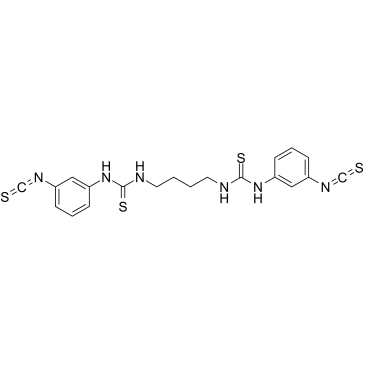| Cas No.: | 711019-86-2 |
| Chemical Name: | Thiourea,N,N''-1,4-butanediylbis[N'-(3-isothiocyanatophenyl)- |
| Synonyms: | MRS-2578; MRS2578 |
| SMILES: | S=C(NCCCCNC(NC1=CC(SC#N)=CC=C1)=S)NC2=CC(N=C=S)=CC=C2 |
| Formula: | C20H20N6S4 |
| M.Wt: | 472.67 |
| Purity: | >98% |
| Sotrage: | 2 years -20°C Powder, 2 weeks 4°C in DMSO, 6 months -80°C in DMSO |
| Description: | MRS2578 is a potent P2Y6 receptor antagonist with IC50 of 37 nM, exhibits insignificant activity at P2Y1, P2Y2, P2Y4,and P2Y11 receptors. |
| Target: | IC50 value: 37 nM [1] P2Y6 receptor |
| In Vivo: | MRS 2578 (10 μM) attenuates Keratinocyte-derived chemokine serum protein levels in LPS-induced vascular inflammation in C57BL/6 mice [2]. MRS2578 (10 μM, intratracheally) reduces BALF eosinophilia and the levels of IL-5 and IL-13 in the BALF in OVA-sensitized mice and leads to a markedly attenuated change in methacholine responsiveness after OVA challenge. MRS2578 (10 μM, intratracheally) inhibits house dust mite–induced allergic airway inflammation in OVA-sensitized mice. MRS2578 (10 μM, intratracheally) reduces of IL-6 and KC levels in BALF in OVA-sensitized mice [4]. |
| In Vitro: | MRS2578 selectively blocks P2Y6 receptor activity versus activity at P2Y1, P2Y2, P2Y4 or P2Y11 receptors. MRS2578 (1 μM) completely blocks the protection by UDP undergoing TNFalpha-induced apoptosis in 1321N1 astrocytoma cells [1]. MRS 2578 inhibits basal NF-κB activity in time and dose dependent manner in HMEC-1 cells transfected with 0.25 μg NF-κB promoter reporter. MRS 2578 (10 μM) completely abolishes TNF-α induced NF-κB reporter activity in HMEC-1 cells. MRS 2578 (10 μM) significant reduces TNF-α–induced proinflammatory gene expression in HMEC-1 cells [2]. MRS2578-treated mice shows reduced bronchial hyperresponsiveness toward methacholine in OVA-sensitized mice. MRS2578 completely blocks UDP-induced the release of IL-6, KC, and IL-8 in lung epithelial cells [3]. |
| References: | [1]. Mamedova LK, et al. Diisothiocyanate derivatives as potent, insurmountable antagonists of P2Y6 nucleotide receptors. Biochem Pharmacol, 2004, 67(9), 1763-1770. [2]. Riegel AK, et al. Selective induction of endothelial P2Y6 nucleotide receptor promotes vascular inflammation. Blood, 2011, 117(8), 2548-2555. [3]. Vieira RP, et al. Purinergic receptor type 6 contributes to airway inflammation and remodeling in experimental allergic airway inflammation. Am J Respir Crit Care Med, 2011, 184(2), 215-223. |

 To enhance service speed and avoid tariff delays, we've opened a US warehouse. All US orders ship directly from our US facility.
To enhance service speed and avoid tariff delays, we've opened a US warehouse. All US orders ship directly from our US facility.




















